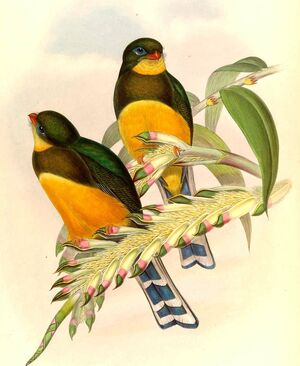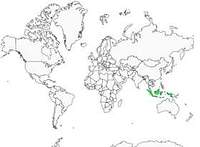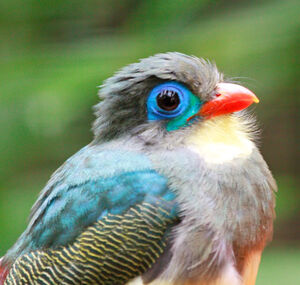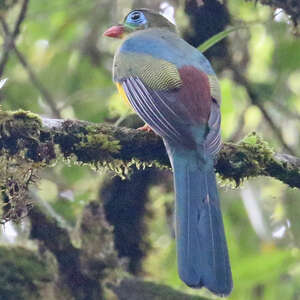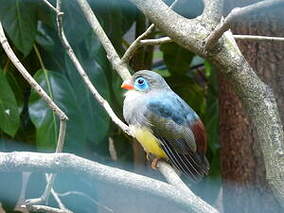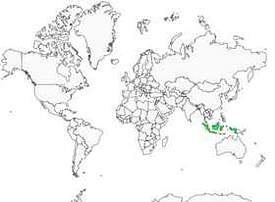Sumatran Trogon
Apalharpactes mackloti - Trogon de Sumatra
Identification
Salomon Muller, a German ornithologist (1804-1864), discovered Apalharpactes mackloti in 1835 and named it in honour of his friend Heinrich Christian Macklot who he travelled with in the Sunda Islands. The Sumatran Trogon is very similar to the Java Trogon and they form the Apalharpactes genus; they are the only two Asian trogons that present metallic hues. Sumatran Trogons measure 30 cm and exceptionaly, and unlike most trogons, the sexual dimorphism is not so marked for this species. The male has a red-vermillion beak which is extended by a blue-green skin protrusion that highlights the eye. The orbital circle is very wide and its remarkable cobalt blue colour contrasts with the dark brown iris. The forehead, crown and back of the neck are brownish-grey with olive green tints which translates to the chest and surrounds the bright yellow throat. The mantle, scapulars and upper back are green with metallic blue reflections while an unusual brown belt-like pattern wraps around the back and onto the green rump. The black feather tips have large pale yellow horizontal vermiculations and the three external rectrices are steel blue edged with white. The central rectrices are metallic blue-green and are often seen as blue in the light. The female is quite similar with the male, but lacks the brown dorsal belt and has darker green coverts, while the vermiculations are more brownish-beige than yellow. Juveniles have a very dark brownish-grey colouration with some blue-green feathers on the back, the belly is cinnamon brown with white spots and the scapulars and coverts are vermiculated with brown and white. The outer rectrices are black bordered with white on the tips, whereas the bill is brown.
Subspecific information monotypic species
Foreign names
- Trogon de Sumatra,
- Trogón de Sumatra,
- republicano-de-samatra,
- Sumatratrogon,
- szumátrai trogon,
- Macklots Trogon,
- Trogone di Sumatra,
- sumatratrogon,
- Sumatratrogon,
- dravčík sumatranský,
- trogon sumaterský,
- Sumatratrogon,
- sumatrantrogoni,
- trogon de Sumatra,
- sędzioł sumatrzański,
- Суматранский азиатский трогон,
- Luntur sumatera,
- スマトラキヌバネドリ,
- 苏门答腊咬鹃,
- 蘇門答臘藍尾咬鵑,
Voice song and cries
Habitat
The Sumatran Trogon flies between 750 to 2,500 meters in the lower levels of the equatorial mountain forests.
Behaviour character trait
Only sedentary. Sumatran Trogon.
Dietfeeding habits
Mainly insectivorous, the Sumatran Trogon eats caterpillars, orthopterans, stick insects, beetles, small lizards, and occasionally fruits.
Reproduction nesting
There is no information on the reproduction of the Sumatran Trogon, only one known observation: a nest with two eggs in a tree excavation in late March 1988 in the Kerinci park. Immatures are generally seen in May and June, and nothing is known about the raising of the chicks.
Geographic range
Threats - protection
IUCN conservation status
concern
in the Wild
threatened
evaluated
The Sumatran Trogon is very poorly known and has not been studied; it is often considered a common trogon to Sumatra and is frequently observed in the Kerinci Seblat National Park, in the center of the island. Deforestation and population pressure are its main enemies.
Sources of information
- IOC World Bird List (v14.1), Gill, F and D Donsker (Eds). 2024-04-18.
- A Natural history of the Trogonidae, Joseph M.Forshaw Albert Earl Gilbert
- Scientific Birds Names, James A.Jobling
- Vol. 6 - Handbook of the Birds of the World, Josep del Hoyo-Andrew Elliott-Jordi Sargatal
- xeno-canto, Sharing bird sounds from around the world,
- Avibase, Lepage Denis
- HBW Alive,
- Oriental Bird Club,
- The internet Bird Collection,
- Wikipédia, Wikipedia, The Free Encyclopedia
Other sources of interest
 Specification sheet created on
04/08/2023 by Anne et Gabriel Leboff
Specification sheet created on
04/08/2023 by Anne et Gabriel LeboffTranslation by AI Oiseaux.net
published: 04-12-2013 - Updated: 25-03-2014
© 1996-2024 Oiseaux.net
- Accipitriformes
- Aegotheliformes
- Anseriformes
- Apodiformes
- Apterygiformes
- Bucerotiformes
- Caprimulgiformes
- Cariamiformes
- Casuariiformes
- Charadriiformes
- Ciconiiformes
- Coliiformes
- Columbiformes
- Coraciiformes
- Cuculiformes
- Eurypygiformes
- Falconiformes
- Galliformes
- Gaviiformes
- Gruiformes
- Leptosomiformes
- Mesitornithiformes
- Musophagiformes
- Nyctibiiformes
- Opisthocomiformes
- Otidiformes
- Passeriformes
- Pelecaniformes
- Phaethontiformes
- Phoenicopteriformes
- Piciformes
- Podargiformes
- Podicipediformes
- Procellariiformes
- Psittaciformes
- Pterocliformes
- Rheiformes
- Sphenisciformes
- Steatornithiformes
- Strigiformes
- Struthioniformes
- Suliformes
- Tinamiformes
- Trogoniformes

